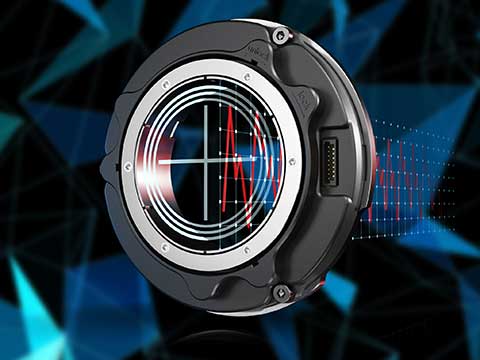
Posted to News on 4th Apr 2024, 13:45
The ECI 123 Splus inductive rotary encoder with built-in vibration analysis
Featuring a built-in accelerometer, the new HEIDENHAIN ECI 123 Splus rotary encoder enables position measurement and vibration analysis in a single component. This added functionality simplifies condition monitoring and maintenance planning in high-wear automated systems.

(See HEIDENHAIN at Machine Building North, 10 April 2025, on stand 40)
Detecting vibrations early is vital for achieving smooth processes, perfect results and long service life in high-performance production automation systems. The earlier the detection, the easier it is to prevent scrap, machine damage and system downtime. By integrating an accelerometer into a rotary encoder, HEIDENHAIN has created a new and convenient solution for detecting and analysing vibrations on rotating machine elements: the inductive ECI 123 Splus.
The ECI 123 Splus delivers position feedback and vibration analysis in a single device. Users benefit from combined motion control and condition monitoring on their rotating machine elements. Linking vibration data with position feedback makes it easier to determine the type and location of the vibration's source. And for even more condition data, the ECI 123 Splus supports up to three connected external temperature sensors. All this data is reliably transmitted for further processing by the EnDat 3 interface. This unique combination of functionality saves on additional vibration sensors while simplifying cabling and installation.
How does the ECI 123 Splus measure machine vibration? With a built-in 3-axis accelerometer and a microcontroller for on-device vibration analysis, including initial order analysis for up to 64 orders. For further analysis later on, the encoder's EnDat 3 interface transmits the purely serial data to the user's downstream electronics. There, OEMs can individualize their analysis based on timing, type, trigger, speed range and measured axis, as well as monitor this data over time for changes to the relevant orders.
In summary, the ECI 123 Splus supports customised online condition monitoring for early fault detection and detailed error analysis. Based on real-world data, machine users can leverage predictive maintenance to optimise machine servicing intervals and anticipate irregular maintenance before malfunctions occur. And when this data is collected over an extended period, users can accurately gauge a machine's remaining service life.
Want the latest machine building news straight to your inbox? Become a MachineBuilding member for free today >>















